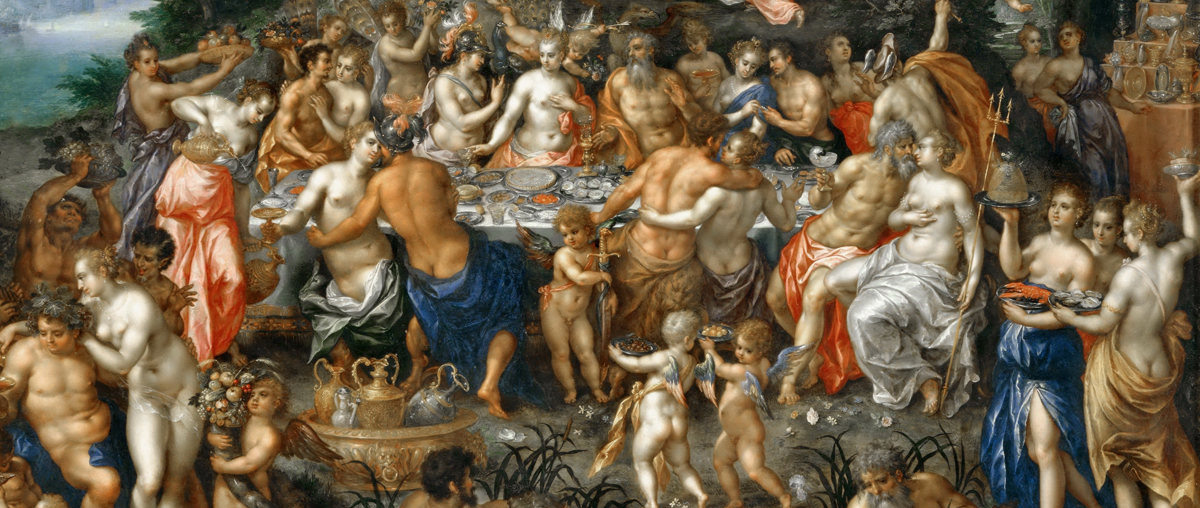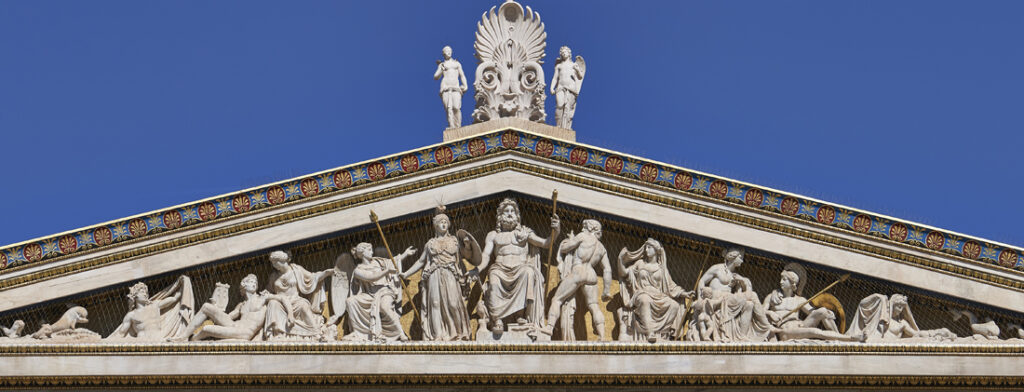Greek mythology gods are explored in these pages with rich details and beautiful images, revealing their strengths, vulnerabilities, and origins in ancient history.
All the gods of Greek mythology become much more fascinating as we discover the details of their attributes, deeds and intimate relationships. They were constantly opposing, rescuing or manipulating other gods, goddesses, exotic creatures and headstrong mortals.
Also intriguing are the new discoveries around the Mediterranean Sea which show some of these myths arose from actual epic events! The first of these was the uncovering of the cities of Troy and Mycenae, which proved the Trojan War and Mycenaean Greeks actually existed. Watch for updates here from many archaeologists and historian Sanford Holst.

Greek Mythology Gods
ZEUS was the most powerful of all the gods on Mount Olympus and ruler of the sky. He frequently was seen holding a bolt of lightning in his hand, and it became his identifying symbol. Zeus also had a stormy and mercurial personality. Despite being married to Hera he was famed for his affairs with many women, including Callisto, Leda and Europa. Zeus was born on the island of Crete, then came to the mainland where he ruled at Olympus. His life followed the same path as the rich culture of the Minoans on Crete which then came to the mainland and flourished among the Mycenaeans.
HERA was the wife of Zeus, notwithstanding the several suggestions that Zeus had other wives as well. She was the goddess of women, marriage and family. Hera was easily recognized by her two unique symbols, the crown and the peacock. A strong, motherly figure, she was also deeply jealous of the women with whom Zeus had his many affairs.
POSEIDON was the brother of Zeus who was venerated as god of the sea, earthquakes and horses. He was usually seen carrying a fisherman’s trident and rising out of the sea. When angered, he would send storms to batter sailors in their ships at sea and earthquakes to terrorize people on land. A strong earthquake zone does in fact extend across the southern islands of the Aegean Sea.
ATHENA was given birth by springing fully armored from the forehead of Zeus. This mythology combined her two major roles as protector of cities and of wisdom. She was generally portrayed with a helmet and shield, which was quite unusual for women. Athena was also frequently accompanied by an owl or a snake. The owl represented wisdom. The snake may have been a connection back to the prominent snake goddess of the Minoans.
ARES was the feared god of war. While he personified courage and valor, he also at times represented cruelty and brutal behavior. He was a son of Zeus and Hera, with his traditional symbols being the sword and shield. Ares was most prominent during the many battles among Greek cities or against foreign foes such as the powerful Persians. His interactions with the other gods also occurred most frequently during times of war.
DEMETER was goddess of harvests and the fertility of the earth. Her identifying symbols were the cornucopia (horn of plenty), poppies and sheafs of wheat. She was a sister of Zeus, and yet had an affair with him which produced a daughter named Persephone. Demeter and Hera shared the mantle of the revered Mother Nature goddess who once was worshipped in many lands around the Mediterranean in distant antiquity.
APOLLO was the god of prophesy, protection and music. His most famous role was as the deity at Delphi, where his oracle conveyed prophesies to Greek leaders who sought guidance at critical moments. He was the son of Zeus and a beautiful lesser goddess named Leto. Among Apollo’s most frequent identifying symbols were the bow and arrow as well, the lyre and the laurel wreath. Known as a protector of boys, he was the father of Asclepius and therefore a champion of medicine and healing.
ARTEMIS was Apollo’s twin sister and goddess of the hunt. She was recognized by the bow and arrow she almost always carried, and was generally accompanied by a stag with a rack of antlers. She was a maiden goddess and the protector of young women. Artemis was one of the most widely worshiped gods among the ancient Greeks, and her temples were found everywhere. Her magnificent temple at Ephesus was one of the Seven Wonders of the World.
HERMES was the messenger of the gods, easily crossing the distance between gods and mortals with the aid of his winged sandals. In addition to those sandals, he was often portrayed with a winged helmet snf carried a caduceus, which was a wand embellished with two intertwined snakes. Hermes was the protector of travelers, orators, merchants and thieves, all of whom went from place to place in the performance of their activities.
APHRODITE was the popular goddess of beauty, love and procreation. Her recognition symbols were the seashell, roses, doves and swans. She was usually portrayed as the youngest and most beautiful of the goddesses and women in any gathering. Although married to the god Hephaestus, she emulated Zeus by taking many lovers among mortals and the divine. Aphrodite continued the heritage of the Bronze Age Phoenician love goddess known as Astarte, who may have been drawn from earlier Eastern deities.
HEPHAESTUS was the god of blacksmiths, artisans, sculptors and also of volcanoes. He was usually recognized by his hammer, anvil and tongs. The son of Hera, he was nevertheless cast out of Olympus because he was lame. Even so, he made all the weapons of the gods. A particularly beautiful temple to Hephaestus still stands in Athens beside the Agora.
HESTIA was the goddess of the hearth, which held a central place in Greek society. The hearth was the central place of the Greek family, and also of the city-state. The first burnt offering in any domestic sacrifice was to her. And when a city created a new colony, fire was carried from the city’s Hestia hearth to the colony which allowed it to function. Hestia was the older sister of Zeus, reflecting the antiquity of her worship in Greek society.
DIONYSOS was the Greek god of winemaking, fertility, ritual madness and theater. When the wine festival rituals of Dionysos were brought to Athens, they gave rise to the famous theater plays of Aeschylus, Euripides and other great playwrights. Dionysos was believed to be the son of Zeus and Persephone but traveled in other countries when he was young and arrived in Greece with foreign manners. Drunken debaucheries were often practiced in his name. But his rituals also brought together people from different levels of society and encouraged freedom from tyrants. He was easily recognized by the exotic foreign animals which accompanied him, the wand of fennel he carried, the bunches of grapes nearby, and the ecstatic dancers who followed him.

Gods and Heroes
Always alongside the gods were Greek heroes who often were born of a human parent and a deity. While the gods could dart from place to place at will and move mountains with the wave of a hand, the heroes made their way forward one exhausting epic deed at a time. Heracles, whom the Romans would call Hercules, was often identified as the greatest of these heroes because of the many nearly-impossible tasks he performed.
Perseus, Achilles, Theseus, Odysseus, Bellerophon, Jason and others also stormed through the ancient Greek world subduing monsters or undefeatable foes. We explore their lives here, and the many tempestuous legends which swirled in their wake.
At about the same time as Homer created his oral epics Iliad and Odyssey, a man named Hesiod began to write down what was believed about the Greek mythology gods of his day. These tales will also be told.
The content of this website is drawn from the research of historian Sanford Holst

Updated October 22, 2023
Cloud: Greek mythology gods, Greek heroes
